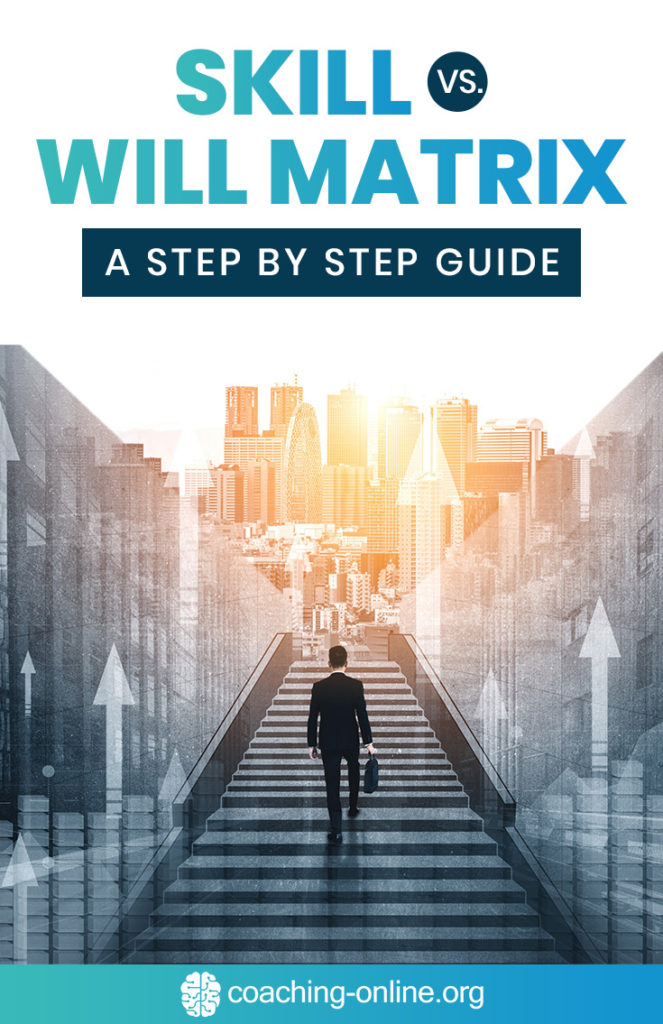Skill vs. Will.
Who is going to win?
“Will is a Skill” – Jillian Michaels.
In this guide, I’ll teach you about the skill will matrix.
Honestly, I wish I knew more about this valuable management tool earlier in my life. The truth is, it would have saved me tons of stress!
Nonetheless, it would have saved me much time and money spent in the wrong direction.
Below, I’ll share all the meaningful information you need.
By the end of this article, you’ll learn how to use the skill will matrix to:
- Determine the best approach to your employees,
- Assess your team member’s UNIQUE qualities,
- Find an excellent solution to a (seemingly) terrible situation/s,
- Boost your business performance (short- and long-term),
…and more!
So, let’s jump in!

Related: The GRPI Model for Effective Teams – Easy Explained
What Is A Skill Will Matrix?
The skill will matrix is one of the most powerful management tools.
By using this tool you can successfully:
- Evaluate a person’s abilities to perform a specific task
- Manage and lead individual members of your business team.
Most importantly, you can create a winning plan of action.
The ultimate goal and major benefit of applying the skill will matrix approach:
- Inform your decisions on how to manage and lead team members,
AND - Help employees achieve the desired results better than ever before.
Your business gains?
By helping an employee unlock his full potential, your company will enjoy tremendous success.
And in fact, this type of success is NOT only limited to the line of work level.
Who Created The Skill Will Matrix?

The skill will matrix was born back in the 1970s.
Moreover, it originates from the model of situational leadership.
The situational leadership model itself was created by Kenneth Blanchard and Paul Hersey.
And so, the skill will matrix is derived from this model.
Finally, it is Max Landsberg’s book entitled “The Tao of Coaching” that made the skill will matrix tool popular.
Max Landsberg himself is internationally recognized as an authority in professional development and executive coaching.
Related: What Are Examples Of Effective Team Dynamics
What Is The Difference Between Skill and Will?

“SKILL” is a word of late Old English origin. It is derived from the word “scele,” which means “discernment” or “knowledge.”
In the Oxford Dictionary, you’ll find the following definition:
- Expertise (the ability to do something well)
- A particular ability.
“WILL” originates from the Germanic word “wollen,” which translates as “wish.”
In Cambridge Dictionary, it is defined as:
- Mental Power (used to control and direct your thoughts and actions, or a determination to do something, despite any difficulties or opposition)
- What someone wants to happen.
Short Summary:
1. Skill refers to a person’s capabilities. These capabilities are unique for each individual, and are based on:
- Training (both previous, as well as ongoing)
- Knowledge (both accumulated and newly attained)
- The specific task a manager has provided
- The natural ability of the individual
2. Will refers to a person’s desire to complete a certain task. The desire to complete particular tasks varies among individuals based on:
- Incentives
- Confidence
- Personal feelings
- Attitude
So far, so good!
But here comes the tricky part…
How Do You Know If It Is A Skill Or A Will?

Below are some of my favorite examples to help you out.
Will is intricately related to two other words:
WILLINGNESS and WILLFULNESS.
If a person has a big motivation to apply his free will in the best way, then he is WILLing to do what it takes to achieve particular goals.
In business environments, achieving a set of goals = managing a set of tasks wonderfully.
And willingness is a HUGE part of any task’s success!
Let’s assume an employee has the WILL to do his jobs at the level he is required to.
Actually, this person may perform above what has been required in the first place.
And that’s because he has the WILLingness to do it.
Willfulness, on the other hand, is like a plague.
A willful person is determined to achieve a goal in a stubborn, perverse way. This never leads to any positive results, though.
A manager (or any leader in general) can teach an employee a skill.
However, this is only possible if the employee does have the WILL to learn. And to do what it takes to master the skill!
In a nutshell:
You can teach somebody the skill only if he has the will to do so.
Not everyone can learn a particular skill, though.
However, anyone can practice the power of his/her WILL.
The thing is, you should never try to teach a fish how to fly, or a bird how to swim, right?
Important!
A manager must know how to be the best coach for his team.
Related: TOP Team Building Consulting Firms You Should Know
List of Skill vs. Will Examples

Here are some more practical examples on that note.
Skills
1. Time management
2. Work ethic
3. Problem-solving
4. Teamwork
5. Creativity
6. Adaptability
…and much more.
So, if a person has the will to manage his time more efficiently, then he can attain this skill.
If a person is not a good team player, he can apply his will power to polish his teamwork capabilities.
However, in both of these examples, there is a catch.
A person may fail to upgrade his skills regardless of the power of his will.
Here is where the skill vs. will leadership tool can be of your best assistance.
Related: Integrated Leadership: Ideas To Be A Better Leader
A Powerful Leadership Tool Explained Easy

The skill – will levels of an individual are assessed on a scale with two axes.
These axes go from low to high and form 4 quadrants.
The four quadrants suggest 4 possibilities for the team leader in terms of boosting business success.
Important Note
The leadership (coaching) style in each quadrant is different, and so it has to be applied accordingly.
Related: Cog’s Ladder Easy Explained Including Its Stages
The Quadrants

The quadrants will show you how to approach the combination of Competence (Skill) + Involvement (Will).
For example, if an individual has a low skill but high will, what should you do?
Should you offer additional training?
Praise?
Provide clear briefings vs. more freedom?
Another example.
May we assume that Jack (a fiction name for person X on your team) has excellent professional skills.
However, Jack’s performance is very poor lately.
After a short conversation of assessing his low will issues, you realize that Jack is trying to get over a breakup.
So, it is the leader’s responsibility to find a way to motivate Jack and help him out.
Your path to success as a leader is easier than you think!
You just need to know how to use the quadrants in the skill vs. will model accordingly.

Related: Be, Do, Have Model Simplified – 12 Facts To Know
1. High Competence + High Involvement
Coaching style:
DELEGATE
- Set the objective and provide FREEDOM
- Give praise instead of ignorance
- Involve in decision making
- Do NOT overmanage
2. High Competence + Low Involvement
Coaching style:
EXCITE
- Identify the reason for low motivation (it may be personal factors, a specific task itself, or/and your management style)
- Monitor
- Provide feedback
3. High Involvement + Low Competence
Coaching style:
GUIDE
- Combine directing + guiding to help build the needed skill
- Answer questions carefully and explain
- Allow “early mistakes” in overcoming the learning curve
- When you notice progress, relax control
4 – Low Competence + Low Involvement
Coaching style:
DIRECT
- Help in building the skill and the will
- Provide clear briefings
- Give specific, accurate instructions
- Identify what motivates the individual
- Offer training and mentoring
- Give frequent feedback
- Nurture by praising good performance
Additionally, there are other very important notes.
It is a great idea to get equipped with a suitable skill will matrix questionnaire.
The reason?
By doing so you’ll make the most of your time (as well as the time of your team).
Think of the right questions to ask your employees in advance.
This is the smartest way to position every individual into one of the 4 quadrants. Quickly and efficiently.
Nonetheless, it’s the best way to get the results you want.
Related: Ways To Credible Leadership
Will and Skills Model: What Are The Benefits?

Every successful manager has one major task (and sacred responsibility!).
The manager MUST make sure that his leadership style matches the abilities of every employee in the team.
Think about the ways you:
- Identify an individual’s talents,
- Follow up the accomplishment of individual duties,
- Track your employees’ progress,
- Provide support for each of your team members,
- Reward the dedicated effort of an individual who performs above the average level,
- Ensure a positive working experience and environment,
- Address and clear any accumulated tension, issue or mishap
- Offer proper training to help an individual grow with the company
It all boils down to being a better leader!
Working with the skill will matrix can teach you so much about the importance of:
- Proper training,
- High motivation,
- Tasks, time and people management,
- Getting any job done better,
- Developing the right attitude,
- Taking personal responsibility for the success of your company.
After all, a leader is a team’s coach!

Even a new leader can do great with managing his team. As long as the leader is WILLing to develop, too.
You see, the manager is the author of a company’s success story.
But no manager can get all the job done by himself, right?
Simply put, a manager and his team are in this TOGETHER.
Just like seasons change in nature, so you need to stay flexible and open-minded.
A funny question (but a deep one, as well):
Would you wear a swimming suit in January or December when the weather outdoors is freezing cold?
So why would you expect employees will get you the results you want unless…
YOU manage to keep their motivation high?

“The greatest good you can do another is not just share your riches, but to reveal him his own.” – Benjamin Franklin.
The truth is, executive leadership has so much to do with coaching.
It’s important that a leader develops a combination of a life coach and career coach skills.
It may seem counterintuitive to dig deeper on the personal level with your team members.
However, the reason an individual performs GREAT instead of HORRIBLE is not always limited to the professional plane.
Related: Group Polarization – 11 Strategies To Avoid It (Backed By Science)
The Bottom Line
Now it’s your turn!
Share some of the personal knowledge and experience you have with the skill will matrix.
Also, what’s your opinion (and useful tips) on other effective leadership tools?
Join us in the comment box.
Related Content
Getting Over A Breakup Is A Chance: Get Over Your Ex Fast
Achievement Oriented Leadership – A Complete Guide
Online Life Coach: The Complete Guide
Career Coach Online: Top 27 Coaches, FAQ, Certifications – Everything You Need to Know
